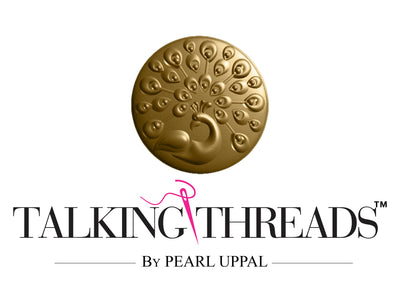Step into the enchanting world of Gota and Marori (Mukaish) embroidery, where threads of gold and silver intertwine to create mesmerizing designs. Originating in India, these exquisite crafts have adorned traditional garments for centuries, adding a touch of opulence and elegance. Welcome to this blog where we explore the fascinating history, evolution, intricate techniques, and modern reinterpretation of Gota and Marori (Mukaish) embroidery. Join us on a journey to discover the enduring charm and contemporary appeal of these shimmering art forms that continue to enchant people around the globe.
Historical Roots & Evolution:
Gota embroidery traces its roots back to Rajasthan, where it was originally practiced by the Mochi community. The art form later spread to other parts of India, including Gujarat and Uttar Pradesh. On the other hand, Marori (Mukaish) embroidery, also known as Badla work, has its origins in Lucknow, the city of nawabs. These crafts flourished under royal patronage, reflecting the grandeur and finesse associated with Indian royalty.
The Artisanship:
The artisans carefully shape and stitch the metallic ribbon onto the fabric, following intricate designs with precision and attention to detail. The result is a seamless pattern that exudes elegance and charm.
Similarly, Mukaish craft showcases the expertise of highly skilled artisans who twist thin metallic threads, typically gold or silver, to create dazzling patterns on fabric. These craftsmen insert and twist the metallic wire into the fabric, producing a shimmering effect and adding exquisite detailing to the garment. Both Gota and Mukaish craft exemplify the artistry and dedication of the artisans who pass down these traditional techniques through generations, creating timeless pieces of beauty.

Stitches and Techniques:
Gota Patti work or Gota embroidery involves the application of small pieces of zari ribbon, typically made of gold or silver, onto fabric using the appliqué method. Elaborate patterns are created by sewing down the edges of the ribbon, resulting in intricate and beautiful designs. Widely used in South Asian wedding and formal attire, Gota embroidery adds a touch of opulence and luxury.
Marori craft, on the other hand, is a form of traditional Indian embroidery that is often combined with Gota work to enhance its overall aesthetic. Marori involves the use of metallic threads, such as gold or silver, meticulously stitched onto fabric to create delicate and intricate patterns, adding a shimmering and enchanting effect. The combination of Gota and Marori craft produces a visually captivating embellishment on fabric, with the fine detailing of Marori embroidery complementing the intricate appliqué work of Gota embroidery, resulting in a truly exquisite and luxurious finished product.

Its Remarkable Exclusivity:
What sets Gota and Marori embroidery apart from other crafts is their opulent use of metallic elements. The intricate play of gold and silver threads adds a majestic touch to the fabric, making it suitable for special occasions and celebrations. The reflective nature of these embellishments creates a dazzling effect, capturing the light and exuding an aura of grandeur.
Obstacles & Safeguarding of the Craft
In recent times, Marori and Gota embroidery have faced several challenges. These include the scarcity of skilled artisans proficient in these techniques, the need to safeguard traditional methods in the face of modernization, sourcing authentic materials, competition from machine embroidery, and adapting to changing market demands. Efforts are being made to address these challenges through skill development, preservation initiatives, and exploring new marketing channels. Despite these obstacles, passionate artisans and organizations are committed to ensuring the continued appreciation and growth of these shimmering art forms, bridging the gap between tradition and captivating appeal. With dedication and innovation, Marori and Gota embroidery can continue to captivate hearts worldwide for generations to come.

Modern Adaptation of the Craft:
We at Talking Threads, try to keep the legacy of Gota and Marori embroidery alive, we strive to infuse a contemporary touch into these traditional crafts. By experimenting with colour palettes, incorporating innovative design elements, and exploring unconventional fabrics, we aim to make Gota and Marori (Mukaish) embroidery more versatile and relevant in today's fashion landscape. Our creations blend the timeless charm of these art forms with the evolving tastes of modern-day individuals.
Gota and Marori (Mukaish) embroidery serve as remarkable examples of the enduring magnificence of Indian craftsmanship. As we delve into the profound history, intricate techniques, and cultural significance of Gota and Marori (Mukaish) embroidery, it is essential that we first value and safeguard these invaluable art forms, ensuring their legacy for future generations.

